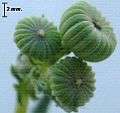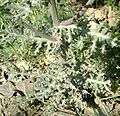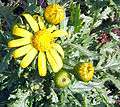Senecio squalidus
| Senecio squalidus | |
|---|---|
 | |
| Scientific classification | |
| Kingdom: | Plantae |
| (unranked): | Angiosperms |
| (unranked): | Eudicots |
| (unranked): | Asterids |
| Order: | Asterales |
| Family: | Asteraceae |
| Subfamily: | Asteroideae |
| Tribe: | Senecioneae |
| Genus: | Senecio |
| Species: | S. squalidus |
| Binomial name | |
| Senecio squalidus L.[1] | |
 | |
| Range of S. squalidus | |
| Synonyms | |
|
Senecio nebrodensis auct., non L. | |
Senecio squalidus, known as Oxford ragwort,[6] is a flowering plant in the daisy family Asteraceae. It is a yellow-flowered herbaceous plant, native to mountainous, rocky or volcanic areas, that has managed to find other homes on man-made and natural piles of rocks, war-ruined neighborhoods and even on stone walls. These habitats resemble its well drained natural rocky homeland. The plants have spread via the wind, rail and the activities of botanists. The travels and discriminative tendencies regarding propagation of this short-lived perennial, biennial, or winter annual make it a good subject for studies of the evolution and ecology of flowering plants.
Description
Like all members of the Asteraceae family, Senecio squalidus has a composite flower head known as a capitulum. What look like single flowers are actually a cluster of florets, each petal or ligule being a flower, or floret, possessing its own stamen and capable of producing the specialized seed of the family Asteraceae, the parachute-like achene.[7]
Oxford Ragwort is a short-lived perennial, a biennial, or a winter annual and grows in a branched straggling form to between 1.5 feet (0.5 m) and 3.3 feet (1 m) depending on conditions. S. squalidus prefers dry, disturbed places, cultivated and waste ground, walls and railway banks,[3][8] flowering from March[9] to December[8] and reproduces from seed.[3]
- Leaves and stems
- S. squalidus leaves are alternate, glossy, almost hairless and variable in form from deeply pinnately lobed to undivided with only the lower leaves being stalked. Stems and leaves resemble those of the common groundsel (Senecio vulgaris)[3][8] with the exception that their lobes are more widely spaced.[10]
- Inflorescence
- S. squalidus has larger capitula than Senecio jacobaea and a more spreading habit.[9] Yellow capitula of 10-14 petals in loose clusters. They are pollinated by insects. Ray corollas .3 inches (8 mm) to .6 inches (15 mm) long, .08 inches (2 mm) to .16 inches (4 mm) wide.[8]
- Oxford ragwort is self-incompatible and needs pollen from other plants with different self-incompatibility alleles;[11]
[12] [13] its own flower possess a stigma with characteristics of both the “dry” and “wet” types.[14]
- The fruiting heads are often nodding.[3]
- Seeds
- Each pollinated Oxford ragwort floret matures into a bell to cylindrical shaped indehiscent achene, the shallowly ribbed fruit is light brown in colour and .06 inches (1.5 mm) to .12 inches (3 mm) long.[8] Each plant can produce approximately 10,000 fruits during the year.[15]
 Mature capitulum
Mature capitulum S. squalidus developing capitula.
S. squalidus developing capitula. Leaves and stalks of S. squalidus.
Leaves and stalks of S. squalidus. Capitula at different stages of development
Capitula at different stages of development
As a Senecio and a diploid Senecio squalidus is part of a species group along with S. flavus, S. gallicus, S. glaucus and S. vernalis, which are widespread geographically and interesting for the study of genetic differences in relation to the environment and plant evolution.[16]
History

This Senecio was introduced into Britain via Francisco Cupani and William Sherard in the years of their visit 1700, 1701 and 1702 from Sicily[17] where it lives as a native on volcanic ash[15] to the Duchess of Beaufort's garden at Badminton. Later a transfer of the genetic material to the Oxford Botanic Garden by the "Horti Praefectus" (the title still given to the head gardener at the Oxford Botanic Garden[18]) Jacob Bobart the Younger before his death in 1719[19] (which is also the same year that Bobart retired as Horti Praefectus[18] and perhaps a good indication of when this species of ragwort and other invasive species might have "escaped" and started to make their home in the greater British Isles). The Sicilian ragwort escaped into the wild and grew in the stonework of Oxford colleges (with the specific mention of the Bodleian Library[9]) and many of the stone walls around the city of Oxford. This gave the plant its common name, "Oxford Ragwort".[20]
Carl Linnaeus first described Senecio squalidus[21] in 1753, although there is a dispute as to whether the material came from the Botanic Garden or from walls in the city; the taxonomy for this species is further complicated by the existence of species with a similar morphology in continental Europe.[19]
James Edward Smith officially identified the escaped Oxford ragwort with its formal name Senecio squalidus in 1800.[19]
George Druce, 1927[19]
During the Industrial Revolution, Oxford became connected to the railway system and the plant gained a new habitat in the railway lines clinker beds, gradually spreading via the railway to other parts of the country. The process was accelerated by the movement of the trains [20] and the limestone ballast that provides a well-drained medium which is an adequate replica of the lava-soils of its native home in Sicily.[19][22]
During the 20th century it continued to spread along railway lines and found a liking for waste places and bombed sites after World War II which have a lot in common with the volcanic regions of home.[9]
Recently, this and other Senecio and their differing tastes for self-incompatibility and self-compatibility have been the subject of study for the purposes of understanding the evolution of plant species as the genus finds new homes and pollen partners throughout the world:
- The origin of Senecio vulgaris var. hibernicus Syme was determined to be an introgression of Senecio squalidus into Senecio vulgaris subsp vulgaris
- The dual origin of S. cambrensis Rosser to both Wales and Scotland explained as being a product parenting by the diploid S. squalidus and the tetraploid S. vulgaris in both locations
- The willingness of S. squalidus to hybridize with Senecio viscosus Crisp & Jones and forms the sterile hybrid S. subnebrodensis Simk.
- The suggestion that S. squalidus is actually a hybrid of two other Sicilian Senecio: S. aethnensis Jan ex DC and S. chrysanthemifolius Poir.[19]
Distribution
Senecio squalidus grows on scree in mountainous regions of native range,[3] and earned its common name Oxford ragwort for its willingness and ability to grow in similar habitat elsewhere in the world.[19]

- Senecio squalidus is considered to be a native of New Brunswick and Nova Scotia, Canada by the USDA Natural Resources Conservation Service while the same USDA other resource Germplasm Resources Information Network considers it to be native to Austria, Czech Republic, Slovakia, Germany, Switzerland, Albania, Bulgaria, Greece, Crete, Italy, Sardinia, Sicily, Romania, Bosnia and Herzegovina, Croatia, the Republic of Macedonia, Montenegro, Serbia, Slovenia.
- Africa
- Northern Africa: Morocco
- America
- North America: New Brunswick, Nova Scotia, British Columbia, California
- Europe
- Northern Europe: Denmark, Germany, Republic of Ireland, Netherlands, Norway, Sweden, United Kingdom
- Middle Europe: Austria, Czech Republic, Hungary, Slovakia, Switzerland
- East Europe: Poland,
- Southeastern Europe: Albania, Bosnia and Herzegovina, Bulgaria
- Southwestern Europe: France, Spain
- South Europe: Croatia, Crete, Greece, Italy, Republic of Macedonia, Romania, Sardinia, Serbia, Sicily, Slovenia
Range Maps
Predators
S. squalidus is a food plant for some insects, for example:
Flies
- Gall flies (Diptera: Tephritidae):
Fungi
Most Senecio, including S. squalidus are susceptible to rust and other fungus and mildews:[27]
- Rust fungus Uredinales
- White rust Peronosporales
- Sac fungus Ascochyta, Pezizomycetes
- Ascochyta senecionicola - (Coelomycete)
- Powdery Mildew Erysiphales
Synonyms and misapplied names
- Jacobaea incisa C. Presl
- Senecio glaber Ucria
- Senecio incisus (C. Presl) C. Presl
- Senecio laciniatus Bertol.
- Senecio nebrodensis auct., non L.
- Senecio rupestris Waldst. & Kit.
- Senecio squalidus d'Urv.
- Senecio squalidus Willd.
- Senecio squalidus M.Bieb.
- Senecio nebrodensis L. subsp. rupestris (Waldst. & Kit.) Fiori
- Senecio leucanthemifolius subsp. vernalis (Waldst. & Kit.) Greuter
- Senecio squalidus subsp. aethnensis (DC.) Greuter
- Senecio squalidus subsp. araneosus (Emb. & Maire) Alexander
- Senecio squalidus subsp. aurasicus (Batt.) Alexander
- Senecio squalidus subsp. aurasiacus (Batt. & Trab.) Alexander
- Senecio squalidus subsp. chrysanthemifolius (Poir.) Greuter
- Senecio squalidus subsp. eurasiacus (Batt. & Trab.) Alexander
- Senecio squalidus subsp. microglossus (Guss.) Arcang.
- Senecio squalidus subsp. rupestris (Waldst. & Kit.) Greuter
- Senecio squalidus subsp. sardous (Fiori) Greuter
- Senecio squalidus subsp. squalidus
- Senecio squalidus var. glaber (Ucria) FIORI
References
- ↑ Natural Resources Conservation Service (NRCS). "PLANTS Profile, Senecio squalidus L.". The PLANTS Database. United States Department of Agriculture. Retrieved 2008-02-14.
- 1 2 Royal Botanic Garden Edinburgh. "Flora Europaea Search Results matching squalidus and Senecio". Retrieved 2008-02-14.
- 1 2 3 4 5 6 7 8 California Department of Food and Agriculture. "Senecio genus". Encycloweedia. State of California. Retrieved 2008-02-13.
- 1 2 The International Plant Names Index. "whole name = Senecio squalidus". Plant Names. Retrieved 2008-02-14.
- 1 2 Botanic Garden & Botanical Museum Berlin-Dahlem. "Details for: Senecio squalidus". Euro+Med PlantBase. Freie Universität Berlin. Retrieved 2008-04-23.
- ↑ "BSBI List 2007". Botanical Society of Britain and Ireland. Archived from the original (xls) on 2015-01-25. Retrieved 2014-10-17.
- ↑ Dr. Gerald (Gerry) Carr, University of Hawaii, Botany Department. "Asteraceae (Compositae)". Vascular Plant Family Systematic Index. Retrieved 2008-02-14.
- 1 2 3 4 5 Brickfields Country Park (2007-12-24). "Oxford Ragwort - Senecio squalidus". Ask Brickfields Country Park a question. Retrieved 2008-02-14.
- 1 2 3 4 Peter Llewellyn (23 August 2004). "Senecio squalidus Oxford ragwort". Wild Flowers of the British Isles. Wild Flower Society. Retrieved 2008-02-12.
- ↑ Department for Environment, Food and Rural Affairs (2000-03-07). "Identification of injurious weeds" (PDF). Farming: wildlife and plants. United Kingdom Government. Retrieved 2008-02-15.
- ↑ Hiscock, S.J. (2000). "Genetic control of self-incompatibility in Senecio squalidus L. (Asteraceae): a successful colonizing species". [Heredity] (published 2000a). 85 (1): 85, 10–19. PMID 10971686.
- ↑ Hiscock, S.J. (2000b). "Self-incompatibility in Senecio squalidus L. (Asteraceae)". Annals of Botany: 85, 181–190.
- ↑ Alexandra Allen. "Identification of genes regulating self-incompatibility in Senecio squalidus (Asteraceae).". University of Bristol, School of Biological Sciences. Retrieved 2008-02-14.
- ↑ Simon J. Hiscock; Karin Hoedemaekers; William E. Friedman; Hugh G. Dickinson (January 2002). "The stigma surface and pollen‐stigma interactions in Senecio squalidus L. (Asteraceae) following cross (compatible) and self (incompatible) pollinations". International Journal of Plant Sciences. University of Chicago, Hyde Park, Chicago: The University of Chicago Press. 163 (1): 1–16. doi:10.1086/324530. 1058-5893/2002/16301-0001. Retrieved 2008-02-14.
- 1 2 "Details for Senecio squalidus L.". The National Biodiversity Network's Species Dictionary. Natural History Museum, London. 1994-08-12. Retrieved 2008-02-14.
- ↑ Peter Hollingsworth; Richard M. Bateman; Richard Gornall (1999). "Monophyly populations and species". Molecular systematics and plant evolution. CRC Press. pp. 504 pages. ISBN 0-7484-0908-4. Retrieved 2008-04-23.
- ↑ University of Catania. "Monti Rossi" (in Italian). Retrieved 2008-02-15.
- 1 2 University of Oxford Botanic Garden. "A History of the Gardens". Retrieved 2008-02-14.
- 1 2 3 4 5 6 7 Harris, S.A. (2002). "Introduction of Oxford Ragwort, Senecio squalidus L. (Asteraceae), to the United Kingdom" (PDF). Watsonia. Botanical Society of the British Isles. 24: 31–43. Retrieved 2008-02-14.
- 1 2 Plant reproduction and speciation group, University of Bristol. "The Oxford Ragwort Story". University of Bristol, School of Biological Sciences. Retrieved 2008-02-13.
- ↑ Swedish Museum of Natural History (2003-08-20). "Senecio squalidus L.". Linnean herbarium (S-LINN). Retrieved 2008-02-14.
- ↑ Chris Gliddon (1998-02-12). "Plant Invasion and Inter-Specific Hybridization". The impact of hybrids between genetically modified crop plants and their related species: biological models and theoretical perspectives. Guide to Risk Assessment and Biosafety in Biotechnology, GRABB, United Nations Environment Programme. Retrieved 2008-02-14.
- ↑ Natural Resources Conservation Service (NRCS). "PLANTS Profile, Nativity of Senecio squalidus L.". The PLANTS Database. United States Department of Agriculture. Retrieved 2008-02-14.
- 1 2 Germplasm Resources Information Network (GRIN) (2007-05-04). "Taxon: Senecio squalidus L.". Taxonomy for Plants. USDA, ARS, National Genetic Resources Program, National Germplasm Resources Laboratory, Beltsville, Maryland. Retrieved 2008-02-14.
- 1 2 Global Biodiversity Information Facility. "Occurrence search Classification includes Species: Senecio squalidus ". Species Data. GBIF Data Portal. Retrieved 2008-02-14.
- ↑ "Senecio squalidus". Artículo de la Enciclopedia Libre Universal en Español (in Spanish). Retrieved 2008-02-14.
- 1 2 "Senecio squalidus L. (Oxford Ragwort)". BioImages: The Virtual Field-Guide (UK). Archived from the original on 2008-09-07. Retrieved 2008-02-14.
- ↑ Missouri Botanical Garden. "TROPICOS Web display Senecio squalidus L.". Nomenclatural and Specimen Data Base. Missouri State Library. Retrieved 2008-02-14.
Further reading
- Harris, S.A. (2002). "Introduction of Oxford Ragwort, Senecio squalidus L. (Asteraceae), to the United Kingdom" (PDF). Watsonia. Botanical Society of the British Isles. 24: 31–43. Retrieved 2008-02-14.
- Abbot, R.J.; Lowe, A.J. (2003). "A new British species, Senecio eboracensis (Asteraceae), another hybrid derivative of S. vulgaris L. and S. squalidae L" (PDF). Watsonia. 24: 375–388. Archived from the original (PDF) on 2007-09-27. Retrieved 2008-02-12.
- Hollingsworth, Peter; Richard M. Bateman; Richard Gornall (1999). "Monophyly populations and species". Molecular Systematics and Plant Evolution. CRC Press. pp. 504 pages. ISBN 0-7484-0908-4. Retrieved 2008-04-23.
External links
![]() Data related to Senecio squalidus at Wikispecies
Data related to Senecio squalidus at Wikispecies
![]() Media related to Senecio squalidus at Wikimedia Commons
Media related to Senecio squalidus at Wikimedia Commons
![]() Media related to Tyria jacobaeae at Wikimedia Commons
Media related to Tyria jacobaeae at Wikimedia Commons
- "Google maps Oxford to Tilehurst". Retrieved 2008-02-14.
- Integrated Taxonomic Information System Organization (ITIS). "Senecio squalidus L.". Integrated Taxonomic Information System on-line database. Retrieved 2008-02-14.
- Flora of North America. "31. Senecio squalidus Linnaeus". pp. Vol. 20 Page 548, 560, 561. Retrieved 2008-02-14.
- Botanic Garden & Botanical Museum Berlin-Dahlem. "Details for: Senecio squalidus". Euro+Med PlantBase. Freie Universität Berlin. Retrieved 2008-02-14.
- "Plants that Grow with Senecio squalidus - oxford ragwort". California Native Plant Link Exchange. Retrieved 2008-02-14.
- Photographer: John Crellin (2006-04-22). "Senecio squalidus photographs for noncommercial use". Flowers that grow in North-Western Europe. Retrieved 2008-02-14.
- "Senecio squalidus". :: Flora of Northern Ireland ::. National Museums and Galleries of Northern Ireland and Environment and Heritage Service. Retrieved 2008-02-14.
- Diane Earl (2006-09-26). "Oxford Ragwort (Senecio squalidus)". Retrieved 2008-02-14.
- Calflora. "Senecio squalidus L.". Information on California plants for education, research and conservation. Retrieved 2008-02-12.


